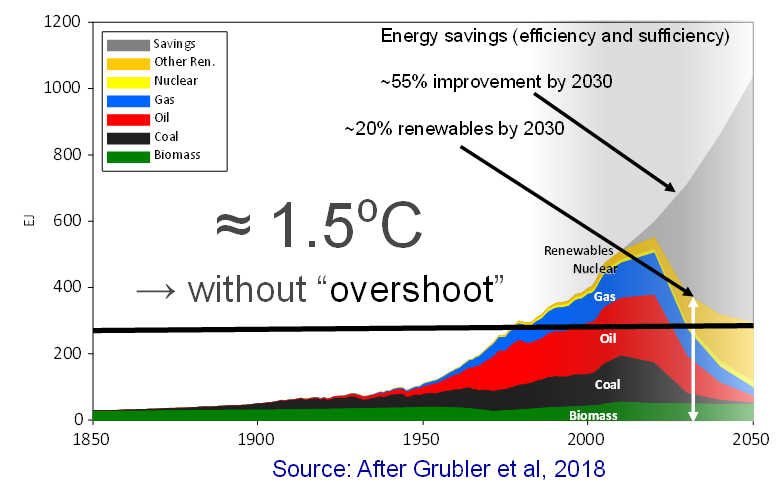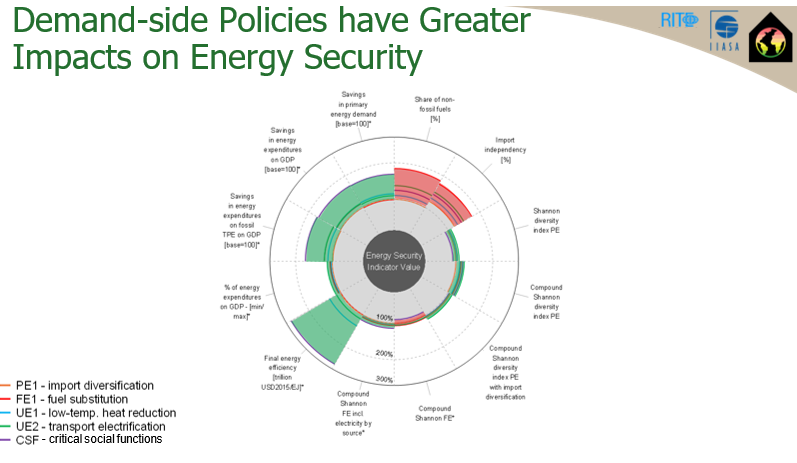
How to prepare better and react easier to disruptions? A discussion was held at the UNFCCC COP28 in Dubai on energy security presenting a new perspective, identifying the multiple benefits a demand-side approach can give when society faces wars, disruptions, recessions and alike.
IIASA and the Research Institute of Innovative Technology for the Earth (RITE) co-organized a hybrid side-event on 11 December 2023 in Dubai in the Japanese Pavilion at the Conference of the Parties of the UNFCCC on promising societal and technological transformations that enable a better response to a variety of disruptions. The seminar discussed energy supply and use disruptions, pandemics, conflicts, as well as more recurring extreme weather events (heatwaves, cyclones, etc.). Innovative demand-based solutions lead to faster, more persistent and more effective outcomes, through focusing on prevention, co-benefits and wellbeing provisions in comparison with supply-side focus.
The side-event highlighted the need for demand-side solutions more than ever both because they are the key for resolving major future challenges, but also because of the growing scientific understanding on the way forward through demand-side solutions. It gathered four eminent researchers from across the world who were also founding organizers of the EDITS initiative.
Energy has been central ever since the dawn of humanity with the discovery of fire, natural energy flows, and during the last two centuries of explosive development that was powered by fossil and now also new renewables and nuclear energy. But there are also major challenges of energy ranging from negative environmental externalities like air pollution, lack of access to energy services by billions, and importantly also climate change. The focus of research and policy has been on securing supply, while it has been known for a long time that demand-side of energy use is the key for resolving many of these challenges. The research on demand-side goes back at least half a century with seminal publications of Lovins in 1976, IIASA publication Energy in a Final World in 1981, the joint IIASA World Energy Council study Global Energy Perspectives in 1988, the Global Energy Assessment in 2012, and the World in 2050 initiative in 2018. These are just a few publications of rapidly emerging literature across the world.
The session was moderated by Nebojsa Nakicenovic (Naki), IIASA, Chief Scientific Advisor to the European Commission. In his opening remarks, Naki outlined the history of the EDITS initiative that builds on the previous research going back the 1970s, the time of the major global energy crises, and more recently the renewed interest to reduce emissions ‘overshoot’ as the global temperature change reached 1.5oC in 2023 and is thus going to exceed the Paris Climate targes (Smith et al. 2016) rendering demand-side solutions central to future steep emissions reductions. In doing so, demand-side solutions would also bring multiple benefits of granular technologies and new behaviors that can be replicated at scale with learning (Wilson et al., 2020), including just access to energy services, reduction of negative environmental externalities, and improved energy security. More recent publications highlight these opportunities and include the LED scenario of Grubler et al., 2018 as input to IPCC Special Report on 1.5°C, IPCC, 2018; IPCC AR6 Chapter 5, Creutzig et al., 2022. He noted that EDITS initiative was formed in 2018, co-organized by IIASA and RITE with funding from METI and that its activities include thematic working groups, quarterly and annual meetings, fast-track research projects, scenario narratives and models.
Keigo Akimoto, Research Institute of Innovative Technology for the Earth (RITE), Japan, spoke about the Importance of demand side solutions for the transformation towards net-zero society. He introduced the G20 Karuizawa Innovation Action Plan on Energy Transitions and Global Environment for Sustainable Growth (June 2019) that emphasizes the importance of modeling and scenarios that include the emergence of artificial intelligence, internet of things, and the circular economy. He highlighted the large opportunities in end-use sectors to reduce GHG emissions with lower costs and that many of the end-use measures will help achieve the multiple SDGs indicating the central importance of demand-side solutions even in a world of disruption. Blocking the way are relatively large hidden costs due to high depreciation rates, high expected price reductions, and bounded rationalities. Digitalization technologies could contribute to reducing the hidden costs as well as inducing circular and sharing economies. In addition, changes to lifestyle preferences for long-term durability of high-quality products will be one of the potential opportunities for decreasing depreciation rates, etc. In conclusion, he stressed the need for a visioning and credible ways forward of inducing demand-side policies.
Nuno Bento, University Institute of Lisbon (ISCTE-IUL) emphasized the Greater leverage for energy security with demand-side policies as energy security is a top priority across the world in these turbulent and challenging times. He showed strong empirical evidence that high efficiency of energy increases resilience and diversity thus leading to higher security.
This is especially the case with demand-side solutions that have substantially greater impacts on energy security compared to supply-side and other parts of the energy system. Higher efficiency of final energy conversion to energy services provides the greatest contribution to energy security that also translates to other security co-benefits like the savings due to energy-demand reduction, lower energy costs, and in particular reduced expenditure on fossil energy including those of imports. In conclusion, he stressed that higher efficiency improves diversity and resilience and that in general demand-side policies are consistently better compared to supply-side across all countries and that diversification of energy has the lesser effect despite being a great focus of security policies.
The third panelist, Diana Ürge-Vorsatz, Central European University (CEU), Intergovernmental Panel on Climate Chante (IPCC) focused on Urban space and society in times of crises: the role of disruptive demand-side innovations. First, she emphasized the importance of demand-side solutions especially for built environment in the Sixth Assessment Report of the Intergovernmental Panel on Climate Change (IPCC). In her contribution she demonstrated that many disruptive innovations exist in demand-side technologies and know-how that jointly have a significant potential for moderating and decreasing the cost global emission reduction and climate resilient development, while also preparing societies for diverse future crises. One of the examples is the energy plus retrofit of the Vienna Technical University tower. In conclusion, she emphasized that the focus on energy-demand side for crisis response and prevention can help maximize many synergies among recovery, social goals, energy security, emission reduction, climate resilience, and in general, crisis resilience. However, she pointed out that while infrastructure-related ones take time, the focus should be to plan and sustain these in non-crisis periods.
The panel presentations were completed by the presentation of Joyashree Roy, Asian Institute of Technology (AIT), Thailand on Bridging the knowledge gap to empower demand-side solutions; with the special emphasis on the Global South. First, she referred to key messages from the IPCC Fifth Assessment Report about the need for reduction in inequity of energy use through demand side actions because demand-side mitigation has potential to reduce supply side decarbonization burden by 40 to 70% by 2050 and that in electrification scenario demand-side solutions have 73% reduction potential. Unfortunately, the current demand-side policies are too fragmented, helping only incremental improvements and too weak to deliver the large untapped potential. This is further hampered by the knowledge gap that favors supply-side solutions, in part owing to the limited availability of information on costs and potential. She highlighted the need for evidence-based data that is currently focus of an EDITS project to compile a global data library for all demand-side solutions.
The panel presentations were followed by a moderated discussion on demand-side innovations and their connection to energy security with the audience present at Japan Pavilion and from the world online. The discussion started on what needs to be done to bring these solutions into the policy, to the private sector, and importantly in all as everyone in the world has to contribute. Dr. Roy mentioned the example of India where many of these changes are happening on the societal level, from the bottom up so to say. This offers new business opportunities that did not exist before. The task of the scientific community is to give confidence and support these important changes. Dr. Ürge-Vorsatz argued that the word ‘demand’ is difficult for policymakers and decision makers because emphasis is on energy security, productivity, tax policies even in the realm of climate change policies. She explained that cardiovascular diseases are closely connected with the quality of buildings and their ability to reduce indoor air pollution. Dr. Bento responded that the world is facing multiple crises, for example in the case of climate crisis there is a lot of action about carbon removal and storage (CCS), in case of energy crisis a lot about renewables and nuclear, but in reality energy efficiency and sufficiency are cheaper and bring more benefits for resolving both climate and energy crises. Dr. Akimoto, referring to the role of the EDITS initiative, highlighted that integration across the globe is essential for the assessment of climate change potential and differing demand-side solutions across the world. Regarding moderator’s question he said that integration is also the key as there are many technological options and policies on the way forward that could bring essential synergies.
Moderator concluded the session by saying that demand-side solutions are one of the great positive stories with multiple benefits in these challenging times of multiple crises facing the world. At the end, he thanked the panelists and the audience both at Japan Pavilion and online for a very interesting, motivational, and productive session. Finally, he also thanked the organizers and colleagues from the Japan Pavilion for hosting the side event and METI from Japan for supporting EDITS.
Upcoming Events
Potsdam Institute for Climate Impact Research (PIK) & Online
German IIASA Networking Event: "Systems analysis for a sustainable and peaceful future"
Online and Austrian Academy of Sciences (Doktor-Ignaz-Seipel-Platz 2, Vienna)
Human Agency to Navigate the Anthropocene
Humboldt University of Berlin





